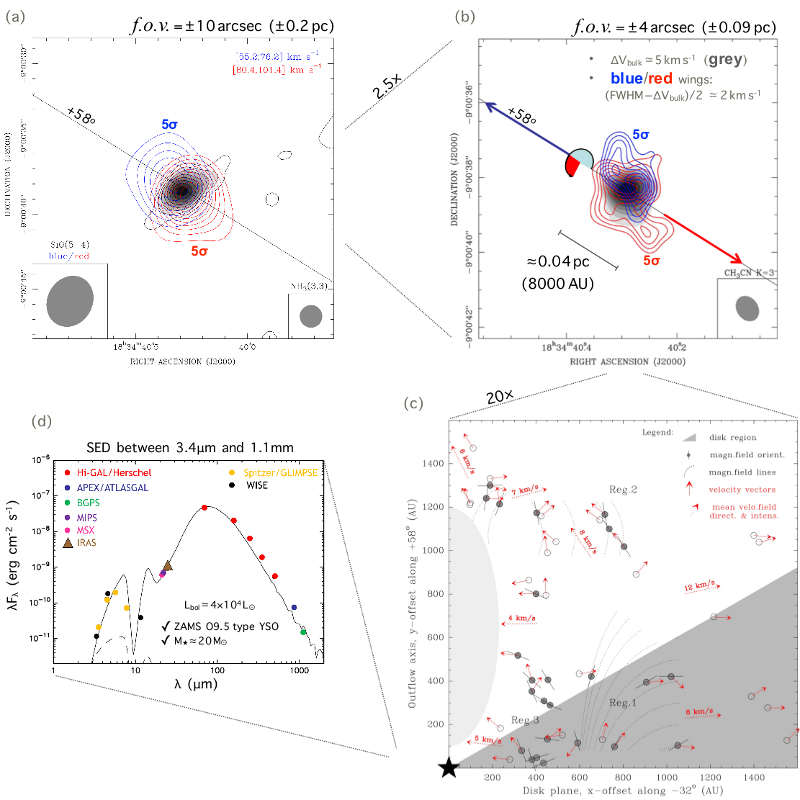| EPoS Contribution |
|
Gas dynamics driven by a massive YSO: Observations confront Theory
Alberto Sanna MPIfR, Bonn, DE | |
|
We will present a comprehensive view (e.g., see Figure), from scales of 0.1 pc
down to 100 AU, of the gas dynamics driven by a massive YSO in the star-forming
region G23.01-0.41, and will compare these observations with ad-hoc MHD simulations,
aimed to reproduce our measurements on a multi-scale view. In this contribution, we will discuss the following observations we have conducted toward the hot molecular core (HMC) of G23.01-0.41: 1) high-sensitivity SMA observations of different molecular lines (e.g., CO, SiO, CH3CN, and CH3OH) at different spatial resolutions in the 230GHz and 345GHz bands; 2) SOFIA observations of the [OI] and [CII] lines, tracing the (collimated) atomic jet component which drives the molecular outflow observed on sub-parsec scales; 3) high-sensitivity JVLA observations of both the radio thermal jet at the base of the molecular outflow, and of the NH3 inversion lines in the HMC; 4) multi-epoch VLBI observations of the rich maser spectra of both H2O and CH3OH species. In particular, we will present the very first detailed picture of both the 3D gas kinematics and magnetic field morphology in the vicinity (< 1000 AU) of a massive YSO, as obtained from 10 AU-resolution observations of the 6.7GHz, CH3OH, maser cloudlets (panel "c" of the Figure). These observations disentangle the complex gas dynamics close to the jet launching region for the first time, and allow us to resolve different gas flows that develop both along the outflow axis and across the disk plane, with an average speed of 7 km/s. In the direction of the outflow axis, we establish a collimation of the gas flow at a distance of about 1000 AU from the disk plane. In the disk region, gas streams outward along the disk plane for radii greater than 500–600 AU and inward for shorter radii. We have been able to reproduce the magnetic field lines for the outer regions (>600 AU) of the molecular envelope, where the magnetic field orientation shows a smooth change with the maser cloudlets position. Overall, the velocity field vectors accommodate the local magnetic field direction well, but still show an average misalignment of 30deg. We interpret this finding as the contribution of a turbulent velocity field of about 3.5 km/s, which would be responsible for breaking up the alignment between the velocity and magnetic field vectors. To date, the mentioned MHD simulations already start to catch most of the details of our observations. | |
 | |
| Caption: Combined view of the gas dynamics driven by a massive YSO at different scales in G023.01-00.41. (a) SiO outflow lobes and outflow direction (NE-SW line) superposed on an HMC map (grey) obtained from the NH3 emission. (b) Quadrupolar morphology of the CH3CN(12-11) K=3 line emission, showing a combined motion of expansion and rotation. (c) Gas dynamics and magnetic field configuration revealed by the 6.7GHz CH3OH masers cloudlets (empty/fill dots for unpolarised/polarised emission) in the vicinity of the HMC center (star), plotted with respect to the outflow axis and the disk plane. (d) Detailed spectral energy distribution derived toward G023.01-00.41, and dominated by a 20 Msun YSO at the center of the HMC. | |
| Collaborators: L. Moscadelli, INAF, IT R. Cesaroni, INAF, IT Q. Zhang, CfA, US C. Goddi, Leiden Obs., NL A. Caratti o Garatti, DIAS, IR G. Surcis, JIVE, NL K. Menten, MPIfR, DE R. Kuiper, Tübingen U, DE A. Kölligan, Tübingen U, DE |
Key publication
Suggested Session: Massive Star Formation |

